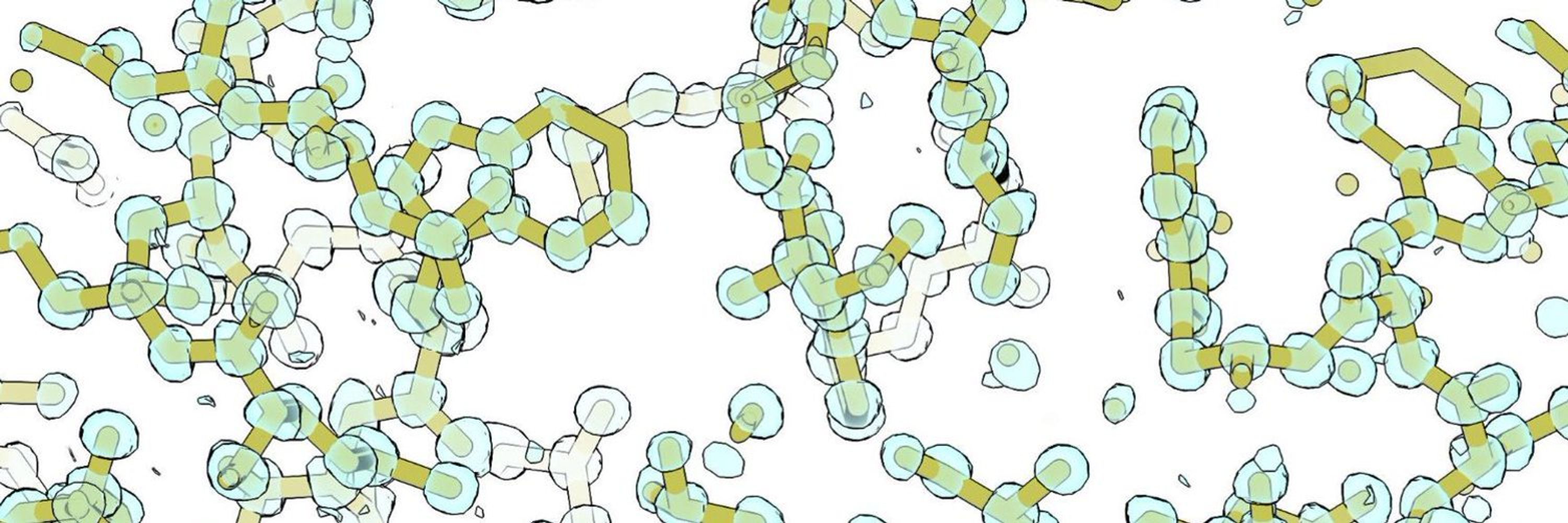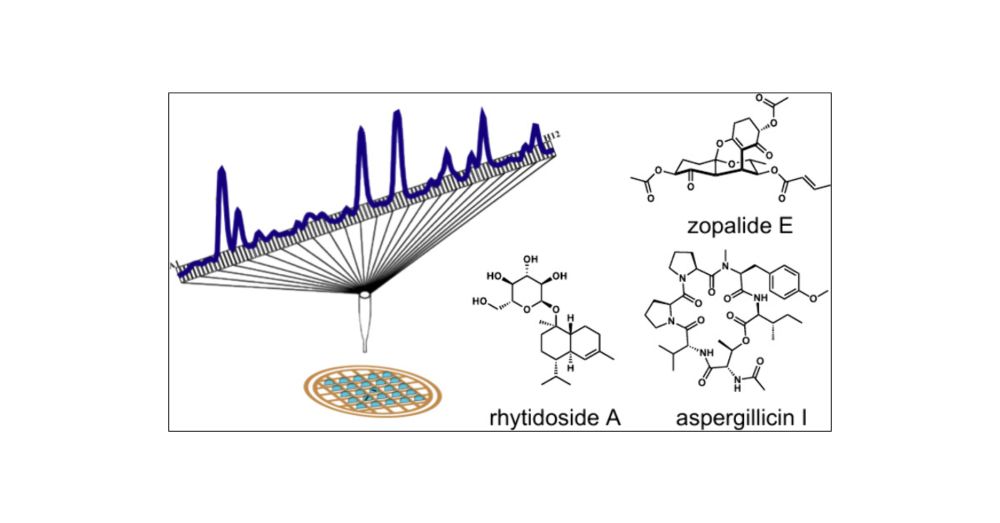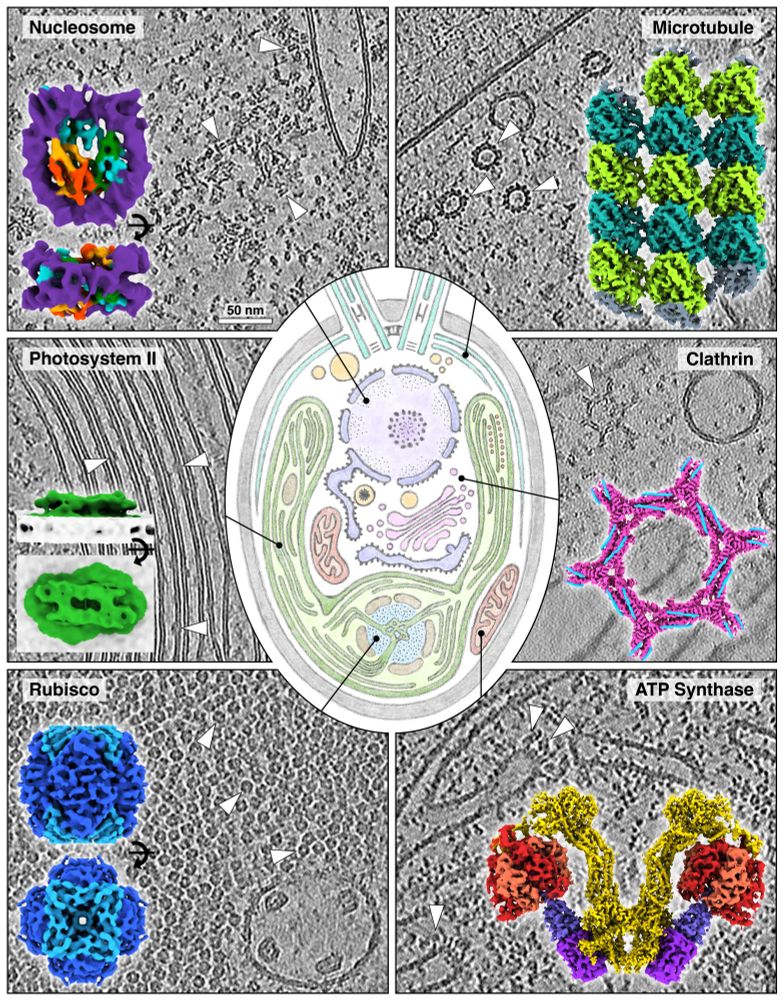
Max Clabbers
@maxclabbers.bsky.social
Assistant Professor at iNANO and MBG, Aarhus University, NNF Hallas-Møller Emerging Investigator
Reposted by Max Clabbers
Seed to sub-Å!
We just solved crambin at 0.85Å with #MicroED straight from spontaneous nanocrystals, phased ab-initio from a 5-res helix. Video shows diffraction ➜ ugly start map ➜ beautiful spheres. Preprint: www.biorxiv.org/content/10.1...
#StructuralBiology #CryoEM
We just solved crambin at 0.85Å with #MicroED straight from spontaneous nanocrystals, phased ab-initio from a 5-res helix. Video shows diffraction ➜ ugly start map ➜ beautiful spheres. Preprint: www.biorxiv.org/content/10.1...
#StructuralBiology #CryoEM
July 5, 2025 at 7:53 PM
Seed to sub-Å!
We just solved crambin at 0.85Å with #MicroED straight from spontaneous nanocrystals, phased ab-initio from a 5-res helix. Video shows diffraction ➜ ugly start map ➜ beautiful spheres. Preprint: www.biorxiv.org/content/10.1...
#StructuralBiology #CryoEM
We just solved crambin at 0.85Å with #MicroED straight from spontaneous nanocrystals, phased ab-initio from a 5-res helix. Video shows diffraction ➜ ugly start map ➜ beautiful spheres. Preprint: www.biorxiv.org/content/10.1...
#StructuralBiology #CryoEM
Reposted by Max Clabbers
There's been a rich connection between electron diffraction and the nature of the chemical bond over the years. Here, we've shown how you can leverage electron diffraction to discover and characterize novel natural products.
@caltechcce.bsky.social @uclacb.bsky.social
pubs.acs.org/doi/10.1021/...
@caltechcce.bsky.social @uclacb.bsky.social
pubs.acs.org/doi/10.1021/...

Microcrystal Electron Diffraction-Guided Discovery of Fungal Metabolites
Nature remains a vast repository of complex and functional metabolites whose structural characterization continues to drive innovations in pharmaceuticals, agrochemicals, and materials science. The cr...
pubs.acs.org
June 3, 2025 at 10:06 PM
There's been a rich connection between electron diffraction and the nature of the chemical bond over the years. Here, we've shown how you can leverage electron diffraction to discover and characterize novel natural products.
@caltechcce.bsky.social @uclacb.bsky.social
pubs.acs.org/doi/10.1021/...
@caltechcce.bsky.social @uclacb.bsky.social
pubs.acs.org/doi/10.1021/...
Reposted by Max Clabbers
Carmine is a red pigment used since antiquity to color textiles, in paintings by Rembrandt and Van Gogh, and today as a food coloring agent (E120).
Very excited that @esvenssongrape.bsky.social finally reveals the crystal structure of carmine by #3DED!
pubs.acs.org/doi/10.1021/...
Very excited that @esvenssongrape.bsky.social finally reveals the crystal structure of carmine by #3DED!
pubs.acs.org/doi/10.1021/...

Brilliantly Red: The Structure of Carmine
Carmine is a red pigment made from dried cochineal, a scale insect that has been a source of brilliant scarlet reds in clothing and art for more than two millennia, with records dating back to 700 BC....
pubs.acs.org
June 3, 2025 at 4:06 PM
Carmine is a red pigment used since antiquity to color textiles, in paintings by Rembrandt and Van Gogh, and today as a food coloring agent (E120).
Very excited that @esvenssongrape.bsky.social finally reveals the crystal structure of carmine by #3DED!
pubs.acs.org/doi/10.1021/...
Very excited that @esvenssongrape.bsky.social finally reveals the crystal structure of carmine by #3DED!
pubs.acs.org/doi/10.1021/...
Reposted by Max Clabbers
Happy to share the latest work from the Gonen lab! A collective effort to solve the structure of the lens membrane protein central to keeping our lenses transparent!
Fluorescent targeted FIB milling, LCP and microED made this possible!
www.nature.com/articles/s41...
Fluorescent targeted FIB milling, LCP and microED made this possible!
www.nature.com/articles/s41...

Structure of the lens MP20 mediated adhesive junction - Nature Communications
Human lens clarity and function depends on well-organized cell junctions. Here, the authors used MicroED to reveal the 3.5 Å structure of MP20, showing that MP20 tetramers form adhesive junctions esse...
www.nature.com
March 27, 2025 at 4:47 PM
Happy to share the latest work from the Gonen lab! A collective effort to solve the structure of the lens membrane protein central to keeping our lenses transparent!
Fluorescent targeted FIB milling, LCP and microED made this possible!
www.nature.com/articles/s41...
Fluorescent targeted FIB milling, LCP and microED made this possible!
www.nature.com/articles/s41...
Reposted by Max Clabbers
WE GOT THE COVER!!!
In a new Science study, cryo–electron tomography captures the in-cell architecture of the mitochondrial respiratory chain, illuminating how the coordinated action of molecular machines drives life’s fundamental energy conversion.
Learn more in this week's issue: scim.ag/3FA3Ygq
Learn more in this week's issue: scim.ag/3FA3Ygq
March 20, 2025 at 7:16 PM
WE GOT THE COVER!!!
Our latest paper is out!
We combine direct electron detection and energy filtering to boost the SNR of our MicroED data
This work was done at HHMI and UCLA with @sciencemick.bsky.social who now runs his own lab at UB-HWI, Johan Hattne, and Tamir Gonen
www.nature.com/articles/s41...
We combine direct electron detection and energy filtering to boost the SNR of our MicroED data
This work was done at HHMI and UCLA with @sciencemick.bsky.social who now runs his own lab at UB-HWI, Johan Hattne, and Tamir Gonen
www.nature.com/articles/s41...

Energy filtering enables macromolecular MicroED data at sub-atomic resolution - Nature Communications
High-resolution data are crucial for accurate structural modeling. Here, authors enhance MicroED data quality using energy filtering, achieving sub-atomic resolution protein data and uncovering diffus...
www.nature.com
March 12, 2025 at 11:02 AM
Our latest paper is out!
We combine direct electron detection and energy filtering to boost the SNR of our MicroED data
This work was done at HHMI and UCLA with @sciencemick.bsky.social who now runs his own lab at UB-HWI, Johan Hattne, and Tamir Gonen
www.nature.com/articles/s41...
We combine direct electron detection and energy filtering to boost the SNR of our MicroED data
This work was done at HHMI and UCLA with @sciencemick.bsky.social who now runs his own lab at UB-HWI, Johan Hattne, and Tamir Gonen
www.nature.com/articles/s41...
Reposted by Max Clabbers
Now online & open access:
Article by Yi Luo, Hao Xu, Yue Han, Xiaodong Zou, Peng Wu & co-workers
Atomic-scale insights into topotactic transformations in an extra-large-pore zeolite using time-resolved 3D electron diffraction
www.nature.com/articles/s44...
#chemsky
Article by Yi Luo, Hao Xu, Yue Han, Xiaodong Zou, Peng Wu & co-workers
Atomic-scale insights into topotactic transformations in an extra-large-pore zeolite using time-resolved 3D electron diffraction
www.nature.com/articles/s44...
#chemsky

Atomic-scale insights into topotactic transformations in an extra-large-pore zeolite using time-resolved 3D electron diffraction - Nature Synthesis
Time-resolved three-dimensional electron diffraction captures reaction intermediates at the atomic scale during the topotactic transformations of a zeolite. It shows the structures of the two extra-la...
www.nature.com
January 13, 2025 at 1:22 PM
Now online & open access:
Article by Yi Luo, Hao Xu, Yue Han, Xiaodong Zou, Peng Wu & co-workers
Atomic-scale insights into topotactic transformations in an extra-large-pore zeolite using time-resolved 3D electron diffraction
www.nature.com/articles/s44...
#chemsky
Article by Yi Luo, Hao Xu, Yue Han, Xiaodong Zou, Peng Wu & co-workers
Atomic-scale insights into topotactic transformations in an extra-large-pore zeolite using time-resolved 3D electron diffraction
www.nature.com/articles/s44...
#chemsky
Reposted by Max Clabbers
Wallenberg Scholar Xiaodong Zou is developing analytical methods that image small molecules in three dimensions and in greater detail than ever before. This opens the way for better drugs and new fundamental discoveries in chemistry. @kawresearch.bsky.social www.su.se/english/news...

Three-dimensional images enhance our molecular understanding of nature - Stockholm University
Three-dimensional images enhance our molecular understanding of nature
Xiaodong Zou has long dreamed of being able to take pictures of the tiniest constituents of nature, such as aromatic substances –...
www.su.se
February 13, 2025 at 8:17 AM
Wallenberg Scholar Xiaodong Zou is developing analytical methods that image small molecules in three dimensions and in greater detail than ever before. This opens the way for better drugs and new fundamental discoveries in chemistry. @kawresearch.bsky.social www.su.se/english/news...
Reposted by Max Clabbers
Happy to share our manuscript on the in situ visualization of the copia retrotransposon in its final form today published in @cellcellpress.bsky.social www.cell.com/cell/fulltex.... What’s new?

March 5, 2025 at 4:02 PM
Happy to share our manuscript on the in situ visualization of the copia retrotransposon in its final form today published in @cellcellpress.bsky.social www.cell.com/cell/fulltex.... What’s new?
Reposted by Max Clabbers
Our work in Nature Comms demonstrates how energy filtering, plasma FIB, and direct electron detectors in counting mode can push MicroED to sub-atomic resolution!
Proud to have done this work back at UCLA. Hoping to bring similar capabilities to Buffalo.
📄 Read the paper: doi.org/10.1038/s414...
Proud to have done this work back at UCLA. Hoping to bring similar capabilities to Buffalo.
📄 Read the paper: doi.org/10.1038/s414...

Energy filtering enables macromolecular MicroED data at sub-atomic resolution - Nature Communications
High-resolution data are crucial for accurate structural modeling. Here, authors enhance MicroED data quality using energy filtering, achieving sub-atomic resolution protein data and uncovering diffus...
doi.org
March 6, 2025 at 7:59 PM
Our work in Nature Comms demonstrates how energy filtering, plasma FIB, and direct electron detectors in counting mode can push MicroED to sub-atomic resolution!
Proud to have done this work back at UCLA. Hoping to bring similar capabilities to Buffalo.
📄 Read the paper: doi.org/10.1038/s414...
Proud to have done this work back at UCLA. Hoping to bring similar capabilities to Buffalo.
📄 Read the paper: doi.org/10.1038/s414...
Reposted by Max Clabbers
To all #TeamTomo #CryoET and #Chlamydomonas aficionados: we have updated EMPIAR-11830 with a bug fix concerning some cryo-CARE denoised tomos as well as additional files and metadata! 🎉👩🏽💻
www.ebi.ac.uk/empiar/EMPIA...
A little thread about what's new... 🧵 1/n
www.ebi.ac.uk/empiar/EMPIA...
A little thread about what's new... 🧵 1/n

February 28, 2025 at 4:35 PM
To all #TeamTomo #CryoET and #Chlamydomonas aficionados: we have updated EMPIAR-11830 with a bug fix concerning some cryo-CARE denoised tomos as well as additional files and metadata! 🎉👩🏽💻
www.ebi.ac.uk/empiar/EMPIA...
A little thread about what's new... 🧵 1/n
www.ebi.ac.uk/empiar/EMPIA...
A little thread about what's new... 🧵 1/n
Reposted by Max Clabbers
Towards community-driven visual proteomics! Excited to finally share this large-scale curated & annotated dataset of 1829 high-quality #cryoET tomograms of the little green alga that just keeps giving— Chlamydomonas! 🧪🧶🧬🌾🌊🌍
Preprint📜: www.biorxiv.org/content/10.1...
A short thread🧵👇
Preprint📜: www.biorxiv.org/content/10.1...
A short thread🧵👇

January 6, 2025 at 11:19 AM
Towards community-driven visual proteomics! Excited to finally share this large-scale curated & annotated dataset of 1829 high-quality #cryoET tomograms of the little green alga that just keeps giving— Chlamydomonas! 🧪🧶🧬🌾🌊🌍
Preprint📜: www.biorxiv.org/content/10.1...
A short thread🧵👇
Preprint📜: www.biorxiv.org/content/10.1...
A short thread🧵👇
Reposted by Max Clabbers
Excited to share our new work! We shed light on the sociology of virus-induced condensates supporting reovirus assembly and replication. Visualized using #CryoET #CryoEM and #FIBmilling
www.nature.com/articles/s41...
Great collab w/ @xianxia13 @zhou_lab Xiaoyu Liu @gonenlab
www.nature.com/articles/s41...
Great collab w/ @xianxia13 @zhou_lab Xiaoyu Liu @gonenlab

Molecular sociology of virus-induced cellular condensates supporting reovirus assembly and replication - Nature Communications
Virus-induced cellular condensates are poorly understood. Using cryoET and cryoEM, the authors visualized the 3D “molecular sociology” of host-virus interactions and choreographed mammalian reovirus a...
www.nature.com
December 9, 2024 at 3:39 PM
Excited to share our new work! We shed light on the sociology of virus-induced condensates supporting reovirus assembly and replication. Visualized using #CryoET #CryoEM and #FIBmilling
www.nature.com/articles/s41...
Great collab w/ @xianxia13 @zhou_lab Xiaoyu Liu @gonenlab
www.nature.com/articles/s41...
Great collab w/ @xianxia13 @zhou_lab Xiaoyu Liu @gonenlab
Reposted by Max Clabbers
Super happy to share our latest work! A detailed protocol for #MicroED sample prep available @NatureProtocols! It covers #FIB, grid making, sample handling, #CryoFLM, and more! Hope it helps!
www.nature.com/articles/s41...
www.nature.com/articles/s41...

Comprehensive microcrystal electron diffraction sample preparation for cryo-EM - Nature Protocols
We present a protocol for preparing microcrystal samples for cryo-EM diffraction imaging, including room temperature solid-state small molecules and soluble and membrane protein crystals.
www.nature.com
December 20, 2024 at 5:19 PM
Super happy to share our latest work! A detailed protocol for #MicroED sample prep available @NatureProtocols! It covers #FIB, grid making, sample handling, #CryoFLM, and more! Hope it helps!
www.nature.com/articles/s41...
www.nature.com/articles/s41...

